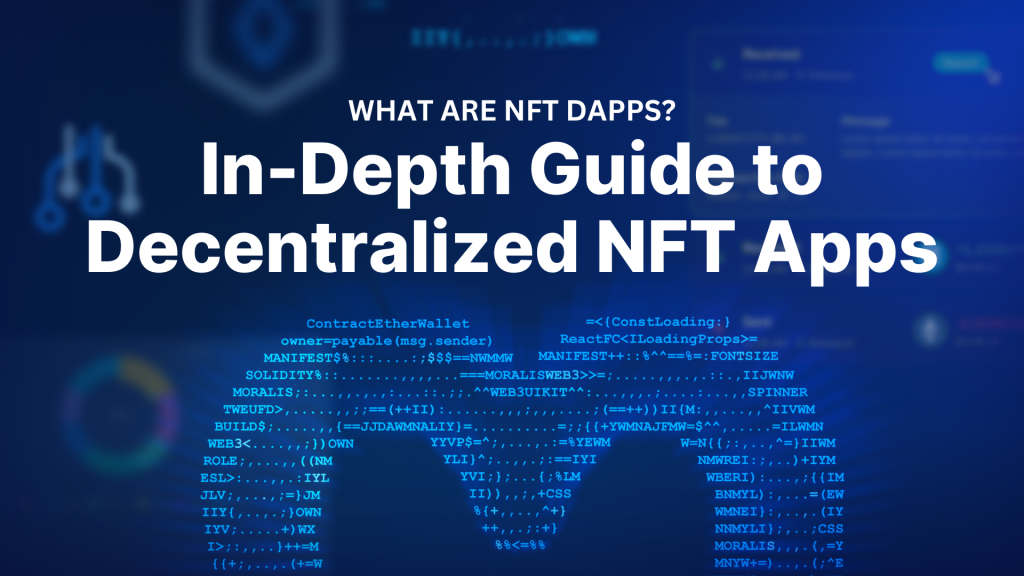
The NFT boom in 2021 – during which the market boasted an annual trading volume exceeding $25 billion – highlighted the potential within the unique digital asset space. And even though trading activity for NFTs has dropped since then, it remains a lucrative industry. Consequently, Web3 developers are still continuously building innovative decentralized applications (dapps) centered around NFTs. But what exactly are NFT dapps? And how do they work? For the answers to these questions, join us in this article as we explore the ins and outs of decentralized NFT apps!
Overview
We’ll kickstart today’s article by diving straight into the intricacies of NFT dapps. In doing so, we’re going to explain what they are and how they work. Next, we’ll explore different types of decentralized NFT apps and cover some prominent examples of already existing platforms. From there, we’ll explain how you can build your own platform, where we briefly outline the typical NFT dapp development process and explore some tools you might find helpful in your endeavors. Lastly, to top things off, we’ll dive into the ultimate tool for NFT development: Moralis’ NFT API!
Moralis’ free NFT API is an industry-leading tool for NFT development, and it’s only one of many premier interfaces in Moralis’ suite of Web3 APIs. Some other prominent examples include the Streams API and Token API. With these tools, you can seamlessly build NFT dapps and any other Web3 platforms without breaking a sweat.
Also, did you know that you can access these Web3 APIs for free? All you have to do is sign up with Moralis, and you’ll gain immediate access to all our industry-leading Web3 development tools!
Now, without further ado, let’s kickstart today’s article by exploring the ins and outs of NFT dapps!
What are NFT Dapps?
In short, blockchain-based applications – also known as decentralized apps (dapps) – that revolve around non-fungible tokens (NFTs) are called NFT dapps. Now, there is a wide range of NFT dapps, with some platforms enabling users to create, buy, sell, and trade NFTs, while others utilize these tokens to represent items in Web3-based games!

Nevertheless, to better understand what NFT dapps are, let’s break down the concept and dive deeper into each component separately. And we’ll start by answering the question, ”What are NFTs?”.
What are NFTs?
NFTs – short for ”non-fungible tokens” – are unique crypto tokens that exist on blockchain networks like Ethereum, BNB Smart Chain (BSC), Polygon, etc. The uniqueness of these tokens and the immutable nature of blockchain networks make NFTs perfect for representing ownership of other on-of-a-kind assets like digital art, videos, images, in-game items, tickets, and much more!
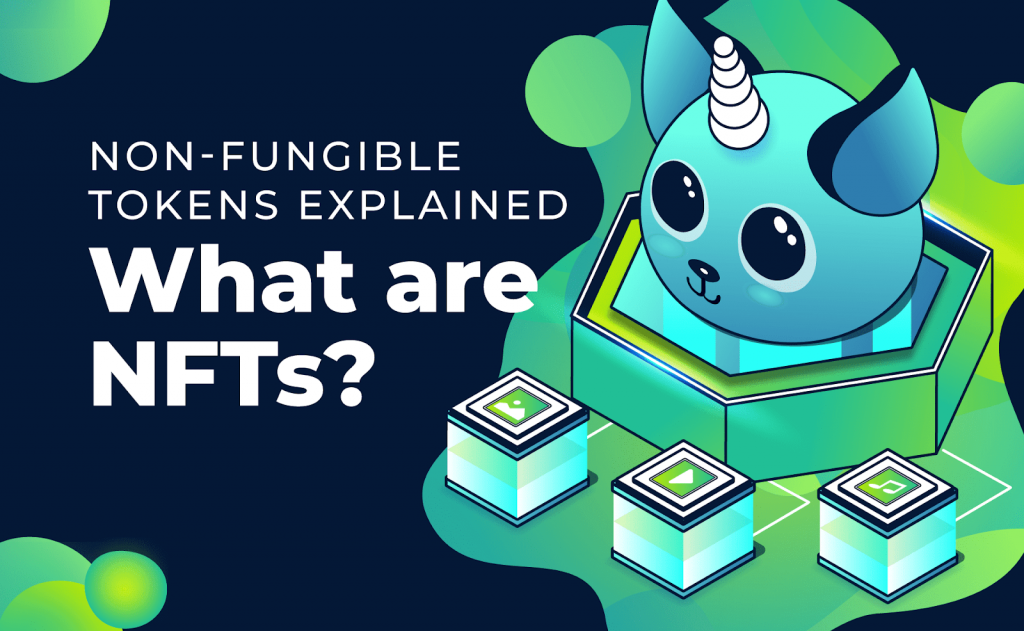
However, it’s essential to emphasize the keywords ”representing ownership”, as the NFTs themselves aren’t images, videos, tickets, etc. Instead, they simply point to another digital or physical item in their metadata.
A good analogy to explain this further is house deeds. A house deed doesn’t contain the actual property but specifies and points to the owner of the asset in question. In the same way, when someone owns an NFT, they essentially have proof of ownership of – and sometimes access to – a digital or physical asset.
All in all, NFTs are one-of-a-kind cryptographic tokens on blockchain networks that typically function as unique identifiers and ownership certificates of other assets!
What are Dapps?
Dapps – which is an abbreviation for ”decentralized applications” – are a new generation of apps built using decentralized technologies such as blockchains and smart contracts. As such, instead of being based on centralized servers like conventional applications, they run on networks like Ethereum, BSC, Polgon, Arbitrum, Optimism, etc.
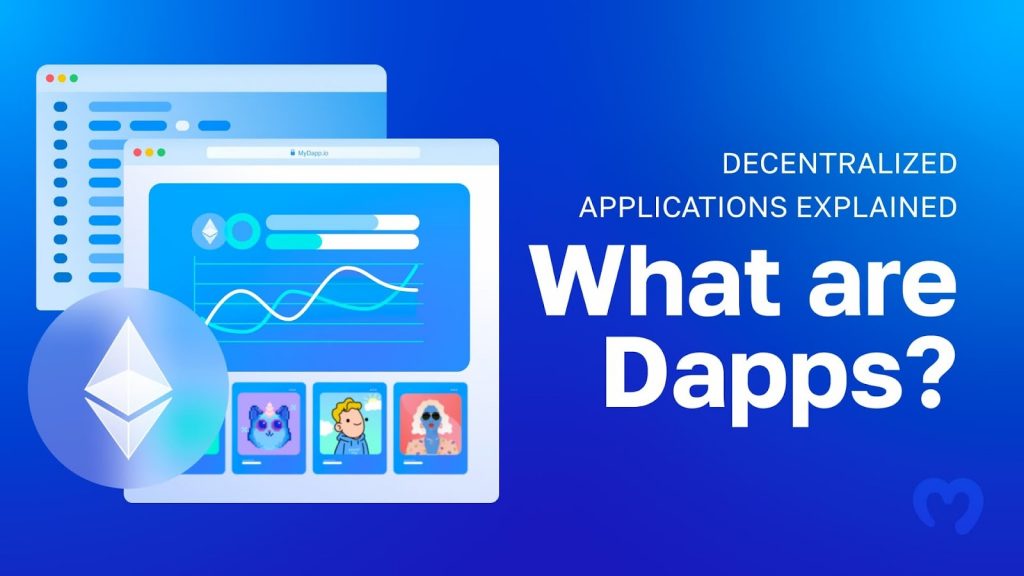
Since dapps are based on peer-to-peer (P2P) blockchain networks, they don’t need to rely on third-party and intermediary involvement in their operations. This is possible due to smart contracts, which are programs running on a blockchain network that execute when predetermined conditions are met. Consequently, smart contracts are perfect for automating processes such as financial transactions.
Dapps typically serve the same purpose and provide functionality similar to traditional applications. As such, they don’t differ much when it comes to user experience (UX). And if they are well-designed, the end users shouldn’t be able to identify any noticeable differences.
In short, the primary distinction between dapps and conventional apps is that dapps leverage decentralized blockchain networks for backend operations and typically use smart contracts to remove the need for unnecessary intermediaries.
So, to summarize, NFT dapps are essentially platforms leveraging the synergistic relationships between the above technologies. And in doing so, they can provide innovative services that incorporate and are centered around NFTs in some capacity!
Different Types of NFT Dapps
To better understand the intricacies of these innovative platforms, we’ll take this section to look into various different types of NFT dapps!
- NFT Marketplaces: Dapps like OpenSea and Rarible are NFT marketplaces providing various services for art and collectibles. On these platforms, it’s possible to mint, sell, buy, and trade NFTs in a P2P manner. By facilitating these services, both OpenSea and Rarible are able to, for instance, provide artists with new ways to claim ownership and monetize their work.
- Gaming Dapps: NFTs are used by platforms like CryptoKitties and Axie Infinity to represent in-game items and characters, which can typically be sold, bought, and traded on various marketplaces. What’s more, combining gaming with blockchain technology has enabled innovative concepts like play-to-earn (P2E), allowing users to earn money by playing Web3-based games.
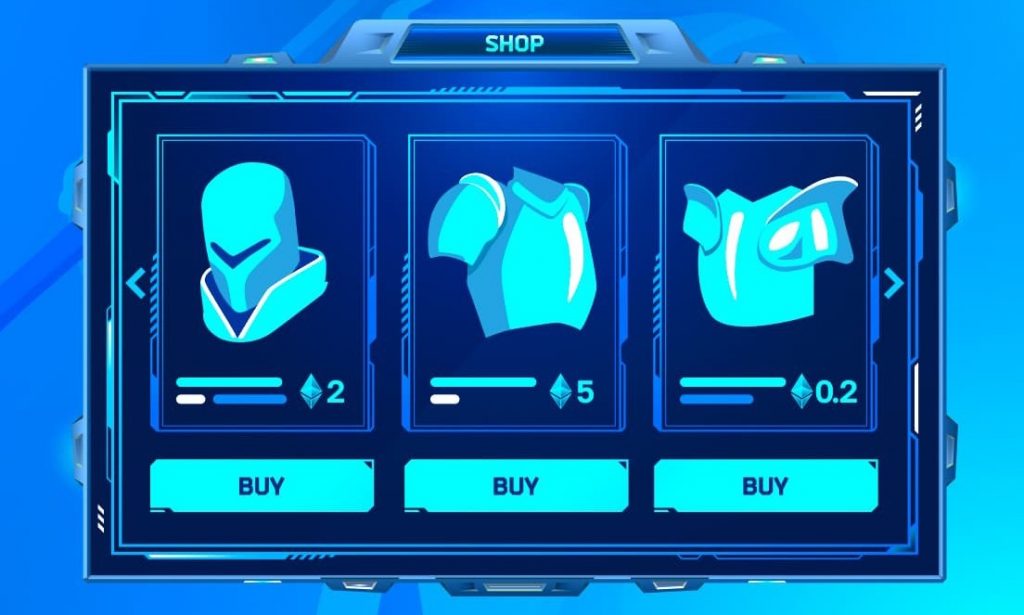
- Decentralized Finance (DeFi) Platforms: NFTs have also found application areas in the DeFi sector. For instance, dapps like Rarible and Aavegotchi explore the integration of NFTs as collateral within DeFi protocols. And in doing so, they allow users to lend or borrow funds against their NFTs.
If you’d like to learn more about this industry, check out our recent article on the ins and outs of DeFi dapp development!
Nevertheless, now that we have explored a few types of NFT apps, let’s take the following section to dive a bit deeper into three actual platforms!
NFT Dapp Examples
In this section, we’ll look at three prominent NFT dapps: OpenSea, Axie Infinity, and Rarible!
- OpenSea: OpenSea was created in 2017, and it is the largest marketplace for NFTs. The OpenSea platform allows users to create, buy, sell, and trade tokens and collectibles in a P2P fashion. Moreover, NFTs listed on OpenSea range from well-known collections like CryptoPunks and Pudgy Penguins to new tokens minted only a few seconds ago.
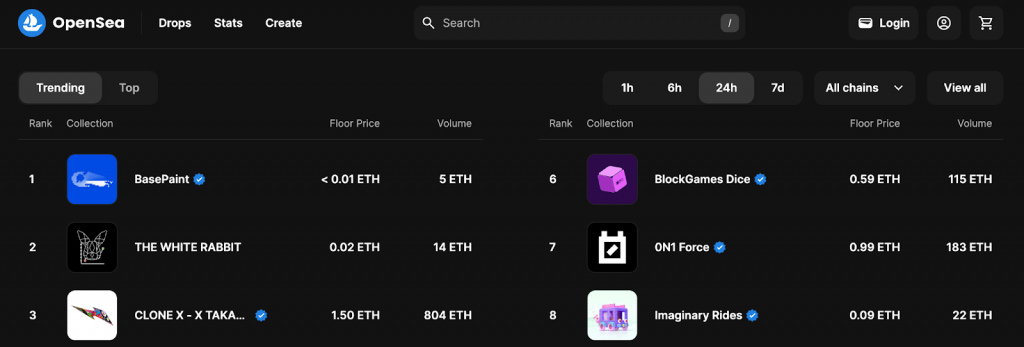
- Axie Infinity: Axie Infinity is a blockchain-based game that gained popularity for its P2E game mechanics. Developed by Sky Mavis, Axie Infinity is a Pokemon-like game where users gather, grow, breed, and battle creatures known as “Axies”. Moreover, NFTs are used to represent these digital creatures, along with abilities, plots of land, and other in-game assets.
- Rarible: Rarible is – much like OpenSea – a decentralized marketplace for minting, selling, buying, and collecting NFTs without the need for intermediaries.
Nevertheless, that briefly covers three examples of prominent NFT-based platforms. If you want to explore other NFT dapps, NFT marketplaces, NFT renting dapps, NFT lending dapps, etc., check out Moralis’ dapp store: Web3 Wiki!
What are the Benefits of Decentralized NFT Apps?
Now, with an overview of what decentralized NFT apps are, let’s look at a few benefits of these platforms:
- Decentralization: NFT dapps run on blockchain networks, meaning they are decentralized. This removes the single point of failure that many conventional applications have, making NFT apps more reliable, censorship-resistant, and challenging to hack.
- Privacy: Interactions with NFT dapps don’t necessarily require sharing personal information, meaning the user retains full ownership of their data.
- Transparency: Public blockchains are generally entirely transparent. As such, when using NFT apps and other decentralized platforms, everyone involved can follow all the activity on the network. This fosters trust and confidence among users as they can verify each transaction independently.
- Efficiency: Decentralized NFT apps can be more efficient than conventional applications as they don’t need intermediaries. As such, with these platforms, it’s possible to streamline transactions and other processes to, for instance, reduce unnecessary costs.
How to Build NFT-Based Dapps
The development process for building an NFT marketplace compared to an NFT game can be completely different. Consequently, we can’t provide a detailed tutorial for all types of NFT dapps. That said, if you would like a specific guide on how to build an NFT marketplace, make sure to check out our article on how to build a Web3 Amazon marketplace dapp! So, while you can follow the previous link to look at the specific steps related to the programming process, we’ll take this section to outline five overarching steps that most development processes follow:
- Define the Concept: Before any development starts, you and your team need to define the concept of your NFT dapp clearly. This includes things such as specifying goals, identifying the user base, etc.
- Project Specifications: Next, you must develop a plan outlining the project specifications. Here, you must choose a blockchain network, identify essential features, find tools to help during development, and more.
- Technical Implementation: Next, you must implement the project specifications and develop your NFT dapp. In doing so, you must build the frontend, write smart contracts, and set up the backend.
- Test and Launch: With a viable product at hand, you must put it through rigorous testing to ensure everything works as intended. When you’re happy with the result, you then need to launch your NFT dapp.
- Maintenance and Marketing: Finally, you need to maintain and market the platform to reach your targeted user base.
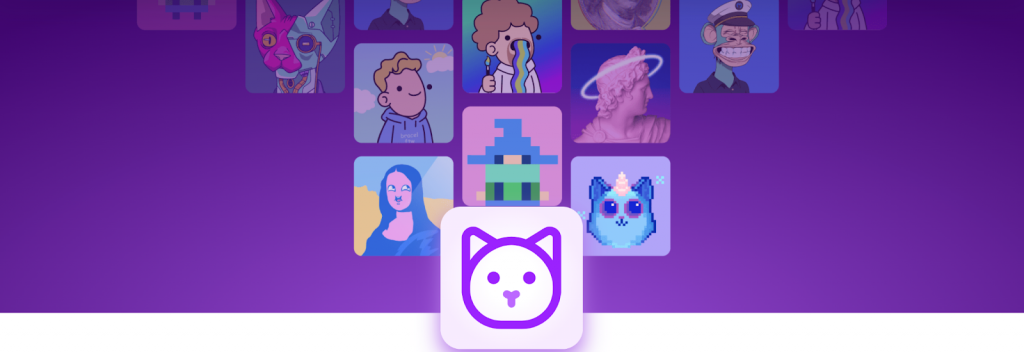
Nevertheless, that gives you an overview of the decentralized NFT app development process. In the following subsection, we’ll explore some tools and programming languages you might find helpful when building your own NFT dapps!
NFT Dapp Tools – Essential Tools and Languages for Building NFT Apps
There are various tools and programming languages that can help you build your own decentralized NFT apps. In this section, we’ll look at three prominent examples:
- Frameworks: Frameworks are code written by someone else that can help you solve common problems more efficiently. Some prominent examples include Hardhat, Truffle, OpenZeppelin, etc. For other alternatives and more detailed information, check out our list of development frameworks on Moralis’ Web3 Wiki.
- Programming Languages: There are multiple programming languages specially designed for Web3 development, and the clearest example is Solidity. Solidity is a contract-oriented programming language for writing EVM-compatible smart contracts. To learn more about this, check out our guide on how to write a smart contract in Solidity.
- Application Programming Interfaces (APIs): A Web3 API is a set of rules, protocols, and methods. Furthermore, a Web3 API allows you to seamlessly query blockchain data and integrate Web3 functionality into your projects. As such, when building an NFT dapp, they can come in quite handy as you don’t have to reinvent the wheel. And the best option on the market is Moralis’ NFT API!
Moralis’ NFT API is the ultimate tool for NFT development. And if you’d like to learn more about this industry-leading interface, join us in the next section.
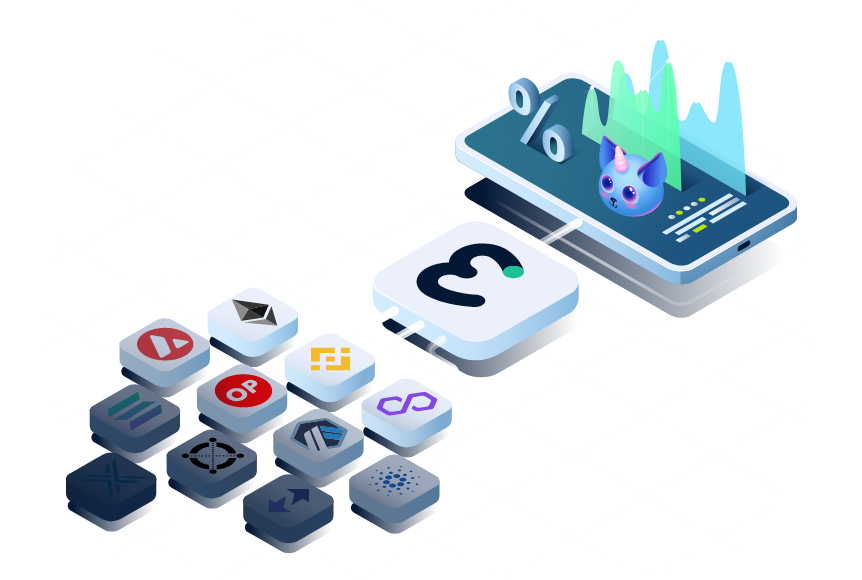
Nevertheless, frameworks, programming languages, and APIs are only a few examples of prominent tools for NFT dapp development. And if you’d like to explore more options, check out our list of NFT tools!
Build NFT Apps with Moralis
It doesn’t matter if you want to build an NFT marketplace or a game; the easiest way to do so is to leverage Moralis’ industry-leading NFT API. The NFT API supports more than three million collections across all the biggest blockchains. For example, these chains include Ethereum, BSC, Polygon, Gnosis, Arbitrum, etc. So, regardless of what type of NFT dapp you want to build or on what network, Moralis has got you covered!
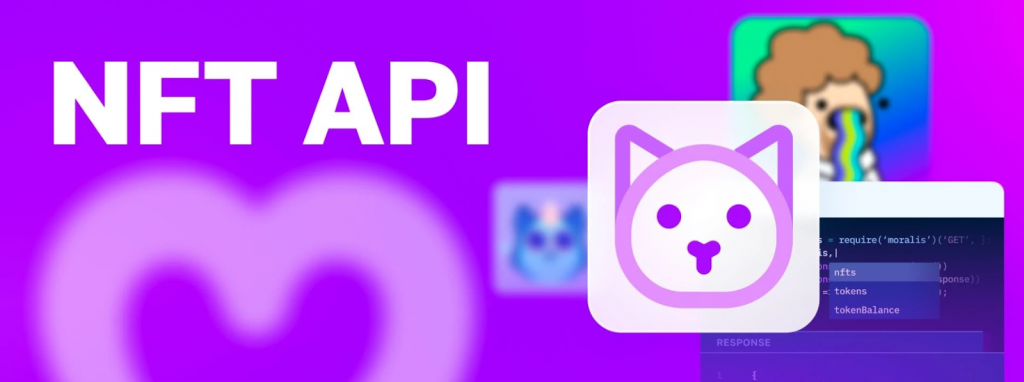
So, what does the Moralis NFT API do?
- Get Real-Time and Historical Data: With the NFT API, it has never been easier to get real-time and historical NFT data. With only single lines of code, you can effortlessly get NFT transfers, enriched metadata, ownership data, and much more.
- Advanced Spam Detection: Protect your platform and users from unwanted NFTs with Moralis’ advanced spam detection feature.
- Query On-Chain Price Data: Fetch and incorporate on-chain pricing data into your dapps, including the last and lowest sold-for prices.
- Optimized Image Previews: Access dynamically sized previews and conversions to user-friendly formats for all NFT images.
- Plug and Play with Other APIs: The NFT API works perfectly with Moralis’ other interfaces. For instance, use the Wallet API to seamlessly integrate wallet functionality into your decentralized NFT app. To learn more about all available interfaces, check out our Web3 API page.
Explore Moralis’ NFT API and discover why it stands out among all APIs by reading our free NFT tools comparison! What’s more, did you know that some of the biggest names in Web3 already leverage Moralis’ APIs? Just check out the following testimonials from MetaMask, Tryhards, and NFTrade:

So, if you have ambitions to build your own NFT dapp, don’t forget to sign up for free with Moralis!
Summary: What are Decentralized NFT Apps? – Exploring NFT Dapps
In today’s article, we dived into the intricacies of decentralized NFT dapps. In doing so, we learned that they are dapps centered around NFTs in some capacity. Platforms like marketplaces allow users to buy and sell NFTs, while others use these tokens to represent in-game items!
In addition to exploring the intricacies of NFT dapps, we also dove into the NFT dapp development. We also outlined the typical process of creating an NFT-based platform:
- Define the Concept
- Project Specifications
- Technical Implementation
- Test and Launch
- Maintenance and Marketing
From there, we also explored Moralis’ NFT API – the ultimate tool for NFT development. With only single lines of code, it’s possible to fetch real-time and historical data. For example, this include transfers, metadata, and much more. As such, when working with Moralis, it has never been easier to build everything from marketplaces to NFT games!

If you found this NFT dapps article interesting, consider checking out more content on our Web3 blog. For instance, read about Web3 as a service or dive into the intricacies of cryptocurrency exchange development.
Also, if you want to build NFT dapps yourself, don’t forget to sign up with Moralis. You can create an account for free, and you’ll be able to leverage the full power of the Web3 industry immediately with our premier APIs!
